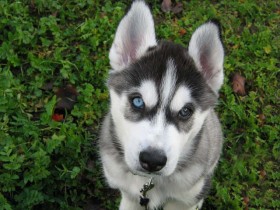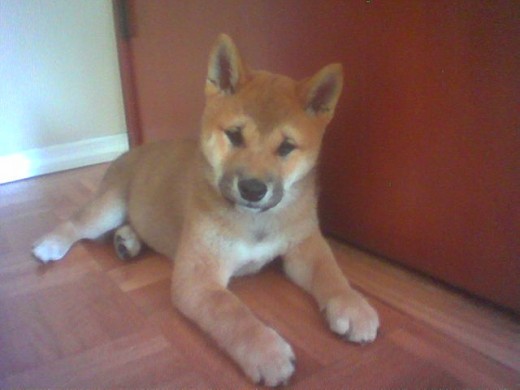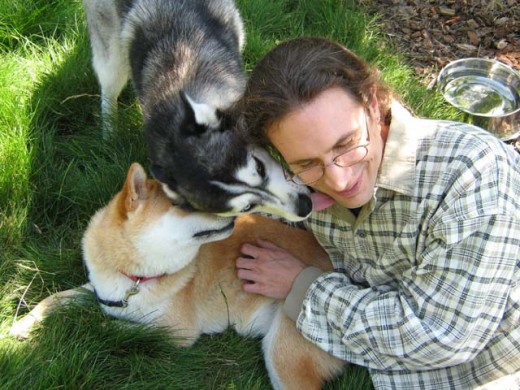Puppy potty training is the bane of many new dog parents. That is why there are so many tutorials on how to housetrain a dog, with promises of how it can be simple and effortless.
The fact though, is that potty training requires time, patience, and consistency. How simple or difficult it is, will depend on our dog’s temperament and our own temperament.


Some dog breeds such as the Shiba Inu, are naturally clean and are relatively easy to housebreak. My Shiba was housebroken when we first got him at 10 weeks old.
Shiba Sephy does not even like to eliminate in our backyard. Instead, he prefers to wait until we go for a walk. In contrast, my second dog (a Siberian Husky), was more difficult to housetrain because she did not mind frolicking close to her own waste products.
It took a few weeks to housetrain her.

Puppy potty training also depends a lot on us. If we are naturally calm, consistent, and patient, housebreaking will seem easier and require less work.
Whatever the case, always remember that we can successfully housetrain a physically healthy dog, at whatever age (after the weaning off process), no matter the history.
And that is a potty training fact!

1. Set Up a Schedule
Puppy potty training begins, by setting up a schedule. Initially, we want to bring our dog out often, and reduce the chances of her making mistakes inside the house.
I observe my puppy closely, and try to identify patterns in her potty behavior. For example, she usually has to go when she wakes up, and after a bit of vigorous play. Therefore, I took her out after nap-time and after every 10-15 minutes of play. Different dogs may have different patterns depending on size, temperament, routine, and more.
I stop giving her water about 2-3 hours before sleep time, and take her out right before I crate her for the night. If I need to reward her during that time, I only use moist dog treats such as boiled chicken, so that she does not get thirsty from them.
Fact – Dogs learn through a process called conditioning. They repeat behaviors that get them good results and stop behaviors that get them bad results.
The more we reward a puppy for eliminating outside, the more she will repeat that behavior. When my puppy does her business in the backyard, I mark that behavior (Yes!). Once she finishes, I treat her with something special that she only gets for potty success, and give her some good affection. Then, I reward her more with play-time and her favorite activities.
Similarly, the more a puppy practices eliminating inside, on her own, the more she will go in the house. After all, it is convenient and nobody is teaching her that it is inappropriate behavior.
Therefore, we want to not only maximize the number of successes, but also minimize the number of mistakes. In this way, our puppy will learn that doing her business outside is extremely rewarding and fun. On the other hand, when she does it inside, she consistently gets interrupted and taken outside.



Myth – My dog cannot be housetrained because she comes from a stubborn breed, she is too stupid, she is too dominant, she doesn’t listen to me, she is too old, etc.
Any physically healthy dog can be housetrained. The key to potty training is patience and consistency. Always be around to supervise our puppy when she is inside. If I do not have the time to supervise, then I crate my puppy or put her in a long-term enclosure with puppy pads.
Myth: Screaming and hitting the dog will show her that I am boss and make her stop pottying inside the house.
Screaming and hitting a dog does not work well, and usually makes things worse. How well do you learn when somebody is screaming at you, or hitting you? It is the same way for a dog, especially a puppy.
The fastest way to housebreak our puppy, is to remain calm, and consistently let her know that going inside is inappropriate (Ack, ack), and going outside is appropriate (Yes).
2. Prevent Potty Mistakes
There are three ways to prevent mistakes inside the house:
a) Be there to supervise.
When our puppy shows signs that she has to go potty, take her outside right away. If I do not catch my puppy in time and she starts to do her business, then I interrupt her with a no-mark (Ack, ack) and take her outside.
Myth – I can potty train my puppy by rubbing her nose in it after the fact. She always looks sheepish and puts her head down when I shout at her. She knows she has done something wrong.
Dogs will only learn when we catch them in the act.
If we are not around and our dog makes a mistake, then we have missed a learning opportunity. All we can do is clean up the mess and move on. It is true that a dog may look sheepish when we shout at her after the fact. This is because she knows that we are upset, so she uses submissive gestures (e.g. putting her head down) to try and appease us.
The dog does not know what particular event has caused our anger, but just that we are angry. Shouting and rubbing a dog’s nose in her own waste does not teach her anything. All it does is confuse our dog, as well as create stress and fear. This can make things worse by causing submissive urination.


b) Crate train our dog.
Dogs do not generally like to soil where they sleep. Keeping our puppy in a crate can discourage her from pottying because she does not want to soil her sleeping area.
When I got my first dog, I was a bit concerned about crating him. Here is what the Humane Society of the United States and the American Dog Trainer’s Network have to say about crate training
Myth – A crate will magically keep my dog from pottying for any period of time.
The crate is not some magical cure. A crate discourages a dog from eliminating, but if a dog absolutely has to go, she has to go.
Keeping a puppy for too long in a crate, will force her to potty in the crate, possibly traumatize her, and greatly set back our potty training program.
The maximum crate time is dependent on the age of our puppy.
| Age | Maximum time in crate |
|---|---|
| 8–10 weeks | 30–60 minutes |
| 11–14 weeks | 1–3 hours |
| 15–16 weeks | 3–4 hours |
| 17+ weeks | 4–5 hours |
Maximum crate time from ASPCA Weekend Crate Training.
Note – this is just a general guideline for the maximum crate time. I usually take my puppy outside more frequently than that. I take her out as soon as she wakes up, and right after any heavy activity.
At night, I crate my dogs in the bedroom. Keeping our dogs with us in the bedroom will help with the bonding process, and show them that they are part of the pack.
When puppies are really young, they may not be able to hold their bladder throughout the night. It may be necessary to make an extra trip outside at night, or really early in the morning. Once they get a bit older though, this will no longer be necessary.
Some puppies, e.g. pet store puppies, may already be conditioned to eliminate in their crate, because they are kept in there for overly long periods of time. In such cases, a crate will no longer be a deterrent to potty behavior.

c) Put our dog in a long-term enclosure.

If I will be away for a long period of time, I put my puppy in a long-term enclosure. This can be a secure puppy pen, or a secure and safe room (e.g. kitchen).
Make sure there is nothing dangerous in the enclosure that our puppy can destroy and swallow. Put bedding, a water bowl, some puppy pads, safe chew toys, and safe food toys, in the enclosure. Put the pads in a corner as far away from the bedding as possible.
Instead of puppy pads, we may also use an indoor grass system. However, some dogs may not like standing on or eliminating on the indoor grass surface. Just using regular sod or grass did not work well for me because of drainage issues. The sod gets smelly very quickly because there isn’t anywhere for the pee to go.
When I tried using sod, I had to change it every other day, or my puppy refused to go onto it. This ended up being a lot more work than just using puppy pads.
Myth – We cannot train a dog to potty outside as well as on puppy pads. She will get confused and not know what to do.
Yes, it is true that if we can be around most of the time to supervise, it is better not to let a puppy do her business in the house at all.
However, if we will be away for long periods of time, if our dog has separation anxiety issues (which may cause her to need to eliminate when we leave), or if there are other medical issues (surgery) that make frequent trips outside unfeasible, then it is perfectly fine to train a dog to both potty on pads, as well as outside.
Reward a puppy for going on his pads, and reward a puppy a lot more for going outside.

3. Clean Away Mistakes Properly
During the housetraining process, there will be some mistakes. When that happens, I calmly no-mark my puppy (Ack, ack) and take her outside. Once we are outside, I praise and reward her if she continues with her business.
Then, I leave my puppy in our fully enclosed and puppy-safe backyard, come in, and clean up the mess. Cleaning up messes in front of a puppy may sometimes cause her to mimic our behavior, and engage in eating her own poop. In her mind, she is only helping to clean out the den.
Use a cleaner that is made especially for pets. A popular pet odor cleaner is Nature’s Miracle.
Do not use ammonia based cleaners as the ammonia odor, which resembles urine, may attract our dog to urinate in the area.

4. Make Sure the Mistakes Are Potty Mistakes
Not all indoor urination is the result of housetraining mistakes. Other reasons for indoor urination include:
- Submissive or excitement urination.
- Medical issues, e.g. urinary tract infection.
- Marking objects or territory.
- Stress or anxiety, which results from being alone or other psychological issues.

I just got a siberian husky she is weeks old. I am a teacher, so i am out of the house from 7-5. Should she be in the crate or an enclosed area. I want to crate train her and house train her. Do you have any suggestions for someone outside of the house?
Hi shibashake,
Although I was reading the article for tips on how to housetrain my shiba, something else caught my eye: your lawn!
What type of grass do you use in y’alls lawn? It looks beautiful!!!
Haha, the grass is called red fescue. It is great for larger yards because it does not require much, if any, cutting. It does like shade though and also needs to be watered, or it could dry out.